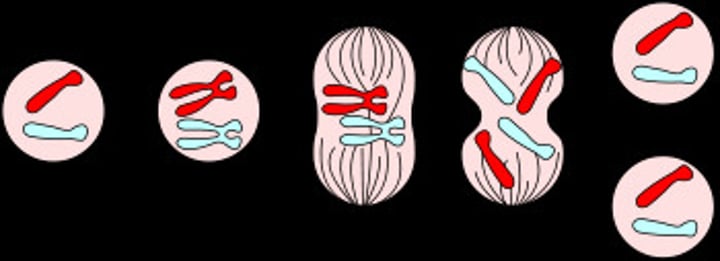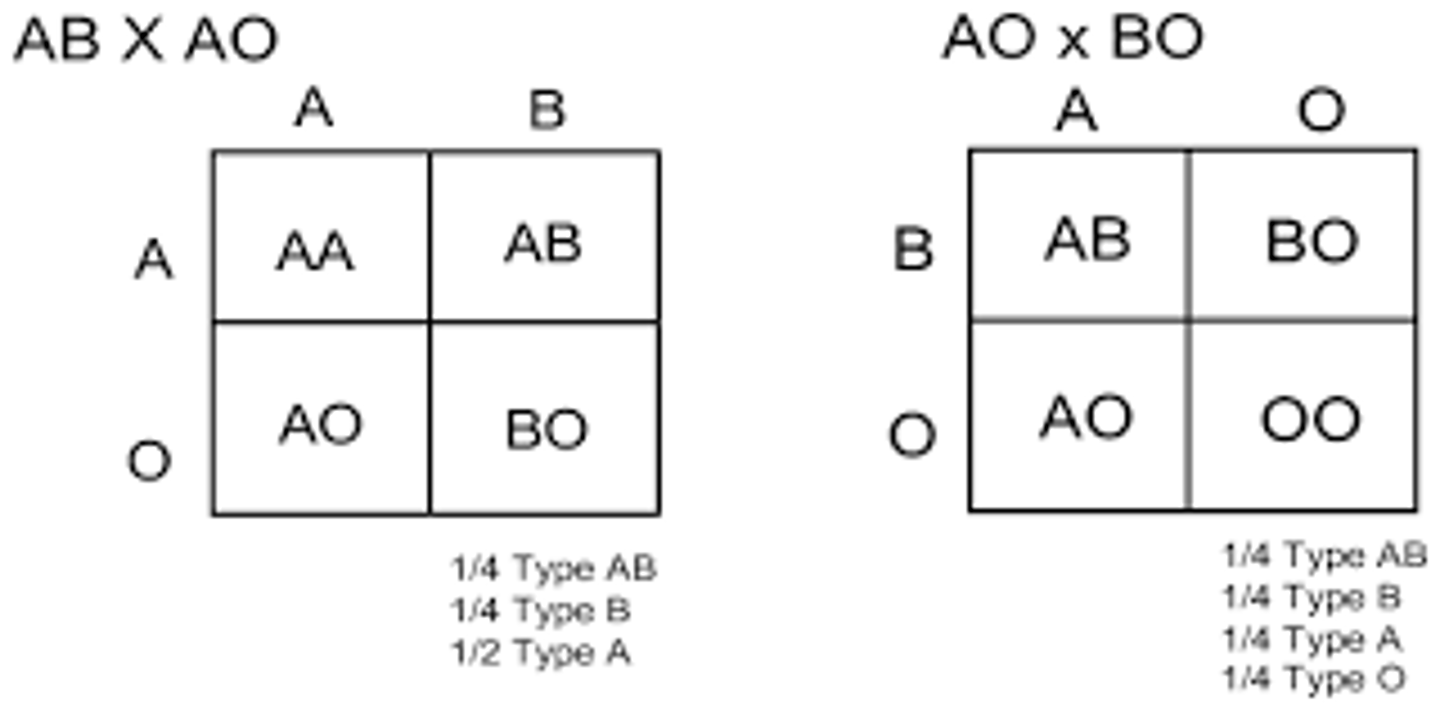GEOSCI 110 EXAM 2
1/111
There's no tags or description
Looks like no tags are added yet.
Name | Mastery | Learn | Test | Matching | Spaced |
|---|
No study sessions yet.
112 Terms
Darwin's Dilemma
-Darwin documented numerous examples of variability and inheritance amongst domestic animals
-The two questions were the following:
1. What is the source of this variability?
2. How does heritability work?
Gregor Mendel
-grew 30,000 pea plants
-closely controlled reproduction and kept careful notes on plant traits generation by generation
-applied statistical principles to biology
Blending Inheritance Hypothesis
Mendel refuted this idea
-hypothesis predicts that each hereditary factor is permanently diluted in a hybrid
-WRONG
What did Mendel discover and how did he do it?
-Mendel proposed discrete units of heredity- the genes
-his prediction: each hereditary factor remains unchanged
Genes
a unit of heredity which is transferred from a parent to offspring and is held to determine some characteristic of the offspring
-may be identical or vary slightly
Locus
the position of a gene or mutation on a chromosome
Alleles
alternative forms of the same gene
Alleles: Recessive
-only expressed when homozygous
-type of allele which will not be manifested in an individual unless both of the individual's copies of that gene have that particular genotype
Alleles: Dominant
-expressed even when heterozygous
-a variation of a gene that will produce a certain phenotype, even in the presence of other alleles
Homozygous
2 alleles are identical
Heterozygous
2 different alleles
Chromosomes
-paired except in reproductive cells
-a threadlike structure of nucleic acids and protein found in the nucleus of most living cells, carrying genetic information in the form of genes.
How many chromosomes do humans have? How many pairs?
46 chromosomes; 23 pairs
Mitosis
part of eukaryotic cell division during which the cell nucleus divides

Meiosis
Cell division that produces reproductive cells in sexually reproducing organisms

Punnett Squares
a chart that shows the possible combination of alleles due to fertilization

Number of Phenotypes v Number of Genotypes
in a Gg x Gg Punnett Square:
F1 phenotype ratio 75% Green, 25 % yellow
F1 genotype ratio 50% Gg, 25% GG, 25% gg
5 tenets of Mendelian Genetics
1. Phenotype traits are determined by units of heredity called genes
2. One gene codes for one trait WRONG
3. Some alleles are dominant others are recessive WRONG
4. Principle of Segregation
5. Principle of Independent Assortment WRONG
Principle of Segregation
Each parent contributes one randomly chosen allele of each gene to each offspring
Principle of Independent Assortment
each pair of alleles (gene) behaves independently of other allele pairs
Commonly observed "Non-Mendelian" characteristics of genes or traits
1. incomplete dominance of alleles
2. codominance of alleles
3. many alleles for one gene in a population
4. one gene may have multiple effects
5. one "trait" may be result of input from many genes
6. genes may influence each other
Example for Incomplete dominance between alleles
Snapdragons:
cross of white with red yields pink
Example of Codominance of alleles
human blood type gene has three alleles (A, B, O)
-Both A and B are fully expressed
Example of More than 2 alleles for one gene
Human blood type
-3 alleles for 1 gene

Example of one gene may have multiple effects
allele for albinism (recessive) also associated with crossed eyes and slightly larger body size
Example of One trait may result from input of multiple genes
human skin color results from combination of serval genes
Examples of genes that may influence each other
coat color in labrador retrievers is controlled by 2 genes
4 basic biomolecules of life
1. Carbohydrates
2. Lipids
3. Proteins
4. Nucleic Acids (DNA, RNA)
DNA Structure
double helix with anti-parallel strands
-holds information to:
-hold proteins
-direct development
DNA
Deoxyribo-Nucleic Acid
3 Reason why we study DNA
1. DNA is the fundamental basis of variation and change
2. DNA operates the same way in ALL living things
3. Many current issues require understanding DNA
Nucleotide Bases
ATCG
Nucleotide Pairings
A-T
G-C
DNA is what "backbone"
sugar-phosephate
Which way do DNA strands go?
they are anti-parallel strands
-5'-->3' direction v 3'-->5' direction
How many times must your DNA replicate itself during your life time?
In humans, DNA is replicated millions of billions times
DNA Replication
the ultimate team sport for enzymes; roles of Helicase, DNA polymerase
Direction of DNA Synthesis
DNA polymerase writes down 5'-->3' and reads up 3'-->5'
DNA replication
lagging (parent) strand runs 3'-->5' versus leading strands running 5'-->3' direction
1. Unzipping
2. A complementary base hooks up to each unpaired base
3. result is two daughter strands: each strand is half old, half new
Okazaki Fradments for building new lagging strand
short sequences of DNA nucleotides (approximately 150 to 200 base pairs long in eukaryotes) which are synthesized discontinuously and later linked together by the enzyme DNA ligase to create the lagging strand during DNA replication.
DNA replication is "semi-conservative" what does this mean?
during DNA replication, the two strands of nucleotides separate. Both strands then form the template for free nucleotides to bind to to create the two identical daughter strands. Hence each daughter strand has half of the DNA from the original strand and half newly-formed DNA.
Where does DNA replication and bundling into chromosomes happen?
inside the nucleus of the eukaryote cells
Carbohydrates
fast energy
Lipids
long-term energy storage, cell membranes
Proteins
build tissues, muscles, immune systems, and enzymes
Nucleic Acids
DNA, RNA
Amino Acids Structure
-Amino Group
-Carboxyl Group
-"R" group
Where does transcription happen?
nucleus
Where does translation happen?
ribosome
What is shared by ALL living organisms?
1. basic DNA structure, including base pairing
2. the genetic code (any particular codon codes for the same amino acid in ALL organism)
3. ALL organisms share about 500 "immortal genes" that are vital to such essential processes as decoding DNA and RNA, and protein synthesis
What is meant by "immortal genes"? Why are they found in all living things?
-a short portion of the amino-acid sequence of a protein found in all domains of life
-amino acids key to specifying this particular protein
What is different in different organisms?
1. sequence of bases along DNA strand
2. Amount of genetic material
3. number of genes and chromosomes
Size of human genome
6.4 billion nucleobases arranged in 3.2 billion base pairs
Is genome size (ie number of nucleobases) a reliable predictor for organism complexity amongst eukaryotes?
No! Among eukaryotes, the amount of DNA an organism has does NOT correlate well with its complexity
How many chromosomes do humans have?
46 (23 pairs)
Is number of conventional, protein-coding genes a reliable predictor for organism complexity amongst eukaryotes?
No! the correlation between the number of conventional (protein-coding) genes and complexity is poor
Is there a correlation between the amount of non-coding "junk" DNA and organism complexity?
No! Humans have a VERY high percentage of non-coding DNA
What percentage of DNA codes for conventional proteins in humans?
1.5% of human DNA codes for protein synthesis, so 98.5% of our genome is non-coding
Gene regulation
Post-Transcription: RNA interference (RNAi)
the ability of cells to control the expression of their genes
Gene Expression
-pre-transcription: transcription factors bind to DNA and regulate RNA polymerase activity; prevent this from happening for a specific gene and that gene is silenced
-post-transcription: interception of mRNA transcription products prior to their translation into protein by ribosome
Micro-RNA (miRNA)
short interfering RNAs, non-coding RNAs present in all living organisms, have been shown to regulate the expression of at least half of all human genes
Transcription Factors
proteins that bind to specific DNA sequences, and control the activity of transcription of genetic information from DNA to messenger RNA (mRNA)
What percentage of our DNA is from viruses?
8.3%
What is used by humans to make the placenta?
virus protein syncytin
Are viruses living organisms?
No
How do some viruses replicate?
1. Virus attaches to and enters a cell
2. virus releases its genetic material
3. Cell's enzymes copy the viral DNA and transcribe viral DNA to RNA
4. Ribosomes in the cytoplasm translate the RNA into viral proteins
5. Viral proteins and viral DNA recombine to form new virus particles
6. New virus particles escape to infect other cells
Where do some scientists think viruses came from?
evolved from plasmids (pieces of DNA that can move between cells)
Plasmids
small, often circular DNA molecule found in bacteria and other cells
-carry a small amount of genes
Two main sources of variation within a species
1. Mutation
2. Recombination (happens during sexual reproduction)
Which has a higher rate of point mutations: viruses or higher eukaryotes?
Viruses
Types of "point mutations" within a DNA sequence & their consequences
a. Single-base substitution
b. insertion
c. deletion
Insertion
extra nucleotide base is accidentally added to DNA sequence
Deletion
nucleotide base is accidentally omitted from DNA sequence
Is evolution a random process?
No! Because natural selection is the filter. Natural selection is NOT random
Synonymous Codons
mutations that DO NOT change the "meaning" of a triplet
Non-Synonymous Codons
mutations that result in the replacement of one amino acid for another
Ratio of Synonymous codons
-expected ratio of non-synonymous: synonymous 3:1
-in nature, ratio is 1:3
Retrovirus (RNA based)
HIV
-are either RNA or DNA (not both, usually RNA)
-may single- or double-stranded
-may be circular or linear
-variable in size: smallest code for only four proteins largest code for >100 proteins
Mutation of CCR5 ∆32-32 BP
detected in humans and resistance to HIV
Pseudogenes
"fossil" genes conserved within the genome that have been rendered useless by mutations
Chromosomal Mutations
changes in the chromosomes where parts of the chromosomes are broken and lost during mitosis
Within a single chromosome:
-deletion
-duplication
-inversion
Between two different chromosomes during meiosis
reshuffles allele combinations
Recombinant chromosomes (sexual reproduction)
source of variation
-crossing-over
-reshuffling of chromosomes
Homeotic Mutations
lead to the wrong body part forming in the wrong place
Homeobox (Hox) genes
large family of genes that direct and coordinate the formation of body parts during early embryonic development
-they encode proteins (transcription factors) that regulate gene expression in multi-cullular organisms
Regulatory genes
genes that control gene expression
Genetic transplantation and knockout experiments
Geneticists removed HOX gene from MOUSE embryo that codes for eye development, and inserted it into the DNA of a developing FRUIT FLY embryo. However, they activated the mouse eyeball HOX gene in a region of the fly that becomes back leg.
-fly grew fly eyes on its leg
Are hox genes shared (phylogenetically conserved) by all animals?
Yes!
Vestigial features (Structures)
degenerate or undeveloped; reduced in size and function by natural selection as no longer required
Atavistic features
reappearance of a trait lost in evolution
-only occur occasionally
why are some genes no longer expressed in a phenotype?
Natural selection and evolution silenced their action by deactivating them, not snipping them out of the DNA
Does natural selection remove "dead" genes (pseudogenes) from genomes?
No!
Embryology
THE STUDY OF EMBRYOS
Ontogeny
The history of development of an individual organism during its lifetime.
Branchial Arches in embyros
fish embryo has a series of gill arches first arch becomes the jaw the rest become gill structures
Replication
embryology reflects evolutionary history through "adding new stuff to old" principle- what is meant by "adding new stuff to old" principle
Carolus Linneaus
Father of taxonomy
Linnaean Hierarchial Classification
A species is a group of individuals that interbreed or have potential to interbreed in nature, and that do not breed with other interbreeding groups
Binomial Naming System
example homo sapiens
-the two part scientific name of a species is called a binomial
-first part of the name is the genus
-second part is called the species